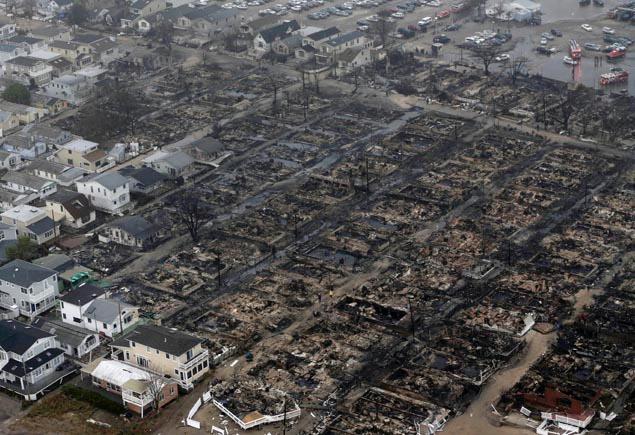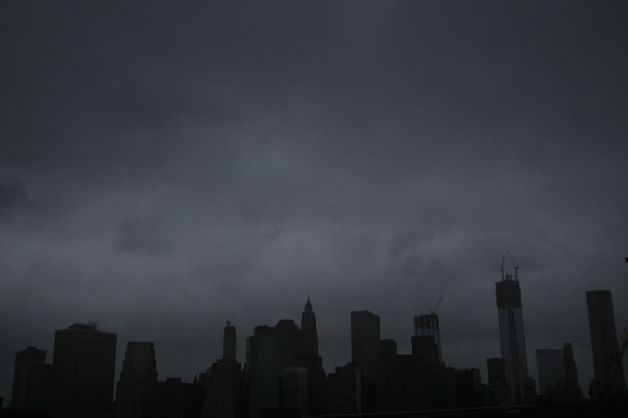by Kit Wainer
November 5, 2012
Here is the first of several dispatches from activists in New York, describing the aftermath of Hurricane Sandy as well as the political issues around aid and recovery.
As I begin writing this on November 2, Homeland Security Secretary Janet Napolitano is speaking in Staten Island. She is rattling off statistics on how much water the federal government is delivering and reminding residents of the island borough of FEMA’s phone number and URL. CNN only seemed to discover the massive death toll, flooding, and destruction in Staten Island 3-4 days after Hurricane Sandy hit the east coast. Staten Island residents, like many outer borough New Yorkers, are starting to recognize the extent to which we are being ignored despite the daily press conferences and repeated shows of politicians thanking and congratulating each other.

How the hurricane affected you depended largely on dumb luck: which neighborhood or which block you lived on. My street in Park Slope, Brooklyn was largely unaffected. Three blocks to the east, trees had fallen on cars. Three blocks to the west was “Zone A,” an area subject to mandatory evacuation. A graduate of the school where I teach was killed last Monday when a tree fell on him. A teacher from my school who lives a block from where the incident happened reported noticing nothing more than a few hours of wind.
As a teacher, I was home Monday through Thursday and had little reason to venture more than a few blocks from my house. Despite the massive news blitz, it is difficult to get concrete information. So many people have no power and cell service is significantly reduced. L., a teacher from my school, lives in Breezy Point, Queens–the Rockaway neighborhood that has become nationally famous for the fire that just wiped out at least 80 homes. After a few days of posting queries on Facebook, I learned that she is fine but her house will be uninhabitable for two to six months. S. and J., two other retirees from my school, live in the Rockaway Park neighborhood where, according to rumors, a fire (or perhaps just flooding?) has wiped out even more homes. Today we got two texts–one said S.’s home was burned down and the other said it was flooded. Nobody knows for sure and no one can contact either of them. Are the stories of the fire true or are people confusing Rockaway Park with Breezy Point, two Irish and Italian working class neighborhoods known for their ethnic identities and racial exclusivity?

Burned-out homes in the Breezy Point section of the Queens after the fire of October 30, 2012. Photo: Mike Groll, AP
On Wednesday, the mayor announced that schools would be closed for students for the remainder of the week but that teachers would report back on Friday. I picked up two colleagues and drove to work this morning. My school is in the Manhattan Beach neighborhood of Brooklyn, part of a string of “Zone A” communities along the coast. Miraculously, the school was untouched–but the streets leading to it were another story. Leaving my house to pick up one teacher near the Barclay Center, the multibillion dollar sports complex which drew the NJ Nets and destroyed the downtown Brooklyn neighborhood a few years ago, I noticed clean streets patrolled by an army of police maintaining steady traffic flows. As we moved south along Ocean Parkway, the story gradually changed. First, there were large trees leaning on houses and smashed cars. Yellow tape but no police, no construction crews, nobody removing the trees. Getting to school required several detours to avoid downed trees. The available streets were mud-covered and occupied by cars oriented in all directions, having been moved by water or wind. No working traffic lights. Cars and pedestrians competed for position in every intersection. Oriental Boulevard runs parallel to the water and leads to my school. No electricity along Oriental, just piles of garbage, discarded mattresses, and furniture. No police, no repair crews, no evidence of any recovery or even cleanup effort.

Ocean Parkway residents wait for limited bus service on October 31. Photo: TWU Local 100
At work, the Department of Education provided no plan for what we were supposed to do in a school without students. The principal began the day distributing information on those staff members who could not make it to work. No injuries were reported, but several homes were destroyed. He then distributed spreadsheets with contact information for the 1000 students, roughly half of whom live in “Zone A.” The city provided no instructions about how the school might assist them, or how we would conduct classes on Monday if, as rumored, at least one other school is relocated into our building to avoid the flood. Several faculty members took their own initiative to begin modest relief efforts. After calling students, a few teachers began packing up food and bottled water to bring to the homes of students who reported having none. Other teachers began coordinating donations to the Rockaways. Teachers who had volunteered in southern Brooklyn and the Rockaways complained that the Mayor is only interested in Manhattan. “He doesn’t care about the worker bees.”
Also demoralizing to some was the looting. One teacher, who is now housing a few families, reported volunteering in Rockaway under National Guard protection against looters. As angry as she was about the looting, she also complained, “Why are there no National Guard units rebuilding Breezy?” I asked several teachers who had assisted friends and family in affected areas if they perceived looters to be hungry people looking for food or criminals taking advantage of a collapse in city administration. “Both,” they replied. Some reported seeing people looking through closed stores for food and others saw people scouting Best Buy.
But, like so many things since the storm hit, it is mostly rumor. It is difficult to know what is happening. I can’t tell what is really happening in Manhattan, which is still dark south of 39th Street. Perhaps residents there are being ignored also.

Teachers who live in less affected neighborhoods are more likely to express anger at politicians still unwilling to deal with global warming. Teachers who can’t return to their homes, or who are helping family members whose lives have been turned upside down, can’t think that big. They’re just angry that the Mayor gets to project a commanding image at daily press conferences while city government in their neighborhoods seems to have disappeared. Whatever the case may be, it’s becoming clear to many here that the policies favoring corporations–from those preventing action against climate change to those that prioritize the needs of the rich over those of working class communities–are as much a culprit in the destruction and continuing problems as the storm itself.
Kit Wainer is a teacher and activist in New York City. He is also a member of Solidarity.
